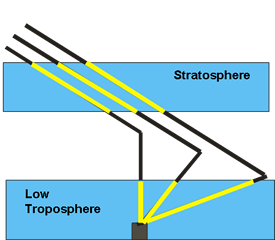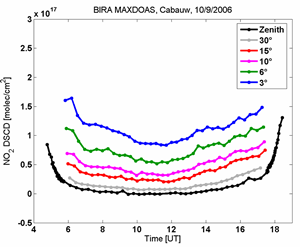|
~
|
MAXDOAS technique The MultiAxis DOAS (MAXDOAS) technique has been recently developed as a new remote sensing tool for the monitoring of tropospheric pollutants by means of the differential optical absorption spectroscopy (DOAS) method (Heckel et al., 2005, Honninger et al., 2004). In contrast to zenith-sky DOAS instruments which have been commonly used over the last decade for stratospheric monitoring and satellite validation, e.g. as part of the Network for the Detection of Atmospheric Composition Change (NDACC), MAXDOAS instruments are designed to allow the quasi simultaneous observation of the scattered sun light in a range of different line-of-sight (LOS) directions from the horizon to the zenith, which leads to increased sensitivity towards atmospheric absorbers present close to the surface. Through adequate retrieval process, the near-surface concentration of atmospheric pollutants like NO2 can be determined, as well as their integrated tropospheric and stratospheric column abundances. DOAS technique The Differential Optical Absorption Spectroscopy (DOAS) technique is based on a modified Beer-Lamber law:

MultiAxis DOAS instruments The MAXDOAS instruments are mainly
By substracting the zenith contribution form the off-axis contribution, the tropopsheric SCD can be obtained during the day. By dividing the tropopsheric SCD by the so-called "Air Mass Factor (AMF)", the tropopsheric vertical columns (VCD) can be retrieved:  Vertical columns
In order to obtain vertical columns from slant columns densities, two approaches
can be considered fopr the calculation of the AMF:
 |





